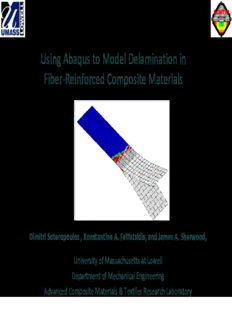
Using Abaqus to Model Delamination in Fiber-Reinforced Composite Materials PDF
Preview Using Abaqus to Model Delamination in Fiber-Reinforced Composite Materials
Using Abaqus to Model Delamination in Fiber-Reinforced Composite Materials Dimitri Soteropoulos , Konstantine A. Fetfatsidis, and James A. Sherwood, University of Massachusetts at Lowell Department of Mechanical Engineering Advanced Composite Materials & Textiles Research Laboratory Outline Background Methodology Finite Element Simulations Summary 2/17 Background – Methodology – Simulations – Summary Simulating the Manufacture of Composite Parts • Increasing use of composite materials (automotive, aerospace, wind energy, marine, military, infrastructure, etc.): • High specific stiffness, • Corrosion and fire-resistance, • Tailored energy absorption • Uncertainties in material behavior and manufacturing processes require simulations to predict part quality Thermostamping process 3/17 Background – Methodology – Simulations – Summary Abaqus Manufacturing Process Simulations Benchmark Exercise: USCAR Project: Double-dome Rear Tub Wind Turbine Blade USCAR Project: 4/17 Floorpan Background – Methodology – Simulations – Summary Linking the Manufacturing Process to In-Service Performance • Forming simulations predict part quality as a result of the manufacturing process • What will the resulting in-service structural performance be? • Stiffness • State of stress • Mode of failure Amplification of strain in a wind turbine blade due to a defect 5/17 Background – Methodology – Simulations – Summary Fabric Material Model • Consider a unit cell of a balanced plain-weave fabric. • A 2-D conventional shell element (S4R) shares its nodes with four 1-D beam elements (B31) • Beam elements carry tensile and bending loads • Shell element defines the shear stiffness of the fabric • Mechanical behavior of the fabric is captured via shear frame, tensile, bending, friction, and bias-extension tests. • Nonlinear constitutive equations are associated with beam and shell elements via user-defined material subroutine in Abaqus/Explicit (VUMAT). 6/17 Background – Methodology – Simulations – Summary Fabric Material Model • Dry fabric model captures the reorientation of the fabric yarns as they conform to a geometry • A method has been developed to capture the structural stiffness of the cured part: • Beam elements represent the infused yarns • Shell elements represent the resin • Tie constraints are currently used to bond multiple layers of fabric together • Assume a perfect bond/no failure criteria • Cannot predict in-service performance and reliability of manufactured parts without the ability to predict potential delamination modes of failure 7/17 Background – Methodology – Simulations – Summary Cohesive Behavior • Defined between contacting shell surfaces • Considers the initial bond strength between adjacent layers • Predicts possible failure of bond due to various loading conditions Two-layer Cohesion not Cohesion defined: specimen loaded defined: Layers Layers buckle in compression act independently together 8/17 Background – Methodology – Simulations – Summary Brittle Fracture in Isotropic Materials • Involves at least two stages: • Crack initiation • Crack propagation • Crack propagation occurs as a function of 1) loading conditions and 2) material properties • Three pure modes of crack propagation: • Opening • In-plane shear • Out-of-plane shear 9/17 Boresi, 2003 Background – Methodology – Simulations – Summary Fracture in Composite Materials • Fracture properties are relatively complex due to anisotropic behavior. • Test methods are different from those used for isotropic materials. • Consider a Mode I (opening mode) failure: • Test setup (ASTM D5528) involves a Double Cantilever Beam (DCB) • Two layers of unidirectional fabric (rectangular, uniform thickness) • Non-adhesive insert is placed in the midplane to serve as a delamination initiator. • Non-adhesive insert is a polymer or aluminum foil film with t < 13 mm. 10/17
Description: